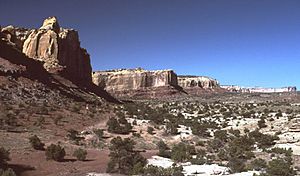Wingate Sandstone facts for kids
Quick facts for kids Wingate SandstoneStratigraphic range: Rhaetian-Hettangian ~206–199Ma |
|
|---|---|

Wingate Sandstone cliffs in the San Rafael Swell, Utah
|
|
| Type | Geological formation |
| Unit of | Glen Canyon Group |
| Underlies | Kayenta Formation |
| Overlies | Chinle Formation |
| Lithology | |
| Primary | Eolian sandstone |
| Location | |
| Coordinates | 39°06′N 109°06′W / 39.1°N 109.1°W |
| Approximate paleocoordinates | 17°42′N 48°18′W / 17.7°N 48.3°W |
| Region | northern Arizona, northwest Colorado, Nevada, Utah |
| Country | |
| Extent | Colorado Plateau |
| Type section | |
| Named for | Fort Wingate |
| Named by | C.E. Dutton |
The Wingate Sandstone is a special type of rock layer. It is found in the Colorado Plateau area of the United States. You can see it in places like northern Arizona, northwest Colorado, Nevada, and Utah. It is part of a bigger group of rocks called the Glen Canyon Group.
Contents
Where Can You See Wingate Sandstone?
This rock layer is very easy to spot. It is especially prominent in southeastern Utah. It forms amazing cliffs in famous places. These include Capitol Reef National Park, the San Rafael Swell, and Canyonlands National Park.
The Wingate Sandstone often sits right below two other rock layers. These are the Kayenta Formation and the Navajo Sandstone. Together, these three layers can create huge, tall cliffs. Some of these cliffs are more than 2,000 feet (609 meters) high!
How Did Wingate Sandstone Form?
The Wingate layers are usually pale orange to red in color. They are the remains of ancient sand dunes. These dunes were formed by wind about 200 million years ago. This was during a time called the Late Triassic period.
What Fossils Are Found in Wingate Sandstone?
For a long time, scientists thought the Wingate Sandstone was only from the Early Jurassic period. But now, fossils and other clues show that some parts are much older. They are as old as the Late Triassic period.
One important fossil found is a skull from a phytosaur. Phytosaurs were ancient reptiles that looked a bit like crocodiles. The upper part of the Wingate Sandstone is indeed from the Early Jurassic period. This part mixes with another rock layer called the Moenave Formation to the west.
Images for kids
-
Hoodoo within the Chinle Formation, west of Moab, Utah. The ridge in the background is part of the Wingate Sandstone.
-
The rock layers of the Colorado Plateau in southeastern Utah. These layers make up many famous rock formations. From top to bottom: Navajo Sandstone, Kayenta Formation, Wingate Sandstone, Chinle Formation, Moenkopi Formation, and Cutler Formation.



